Decision Making Models: Rational vs. Intuitive in Marketing Strategies
VerifiedAdded on 2022/08/29
|9
|2094
|23
Report
AI Summary
This report delves into the critical area of decision-making models within the marketing field, analyzing two primary approaches: the rational decision-making model and the intuitive decision-making model. The rational model, a structured, step-by-step process, emphasizes problem identification, information gathering, situational analysis, option development, alternative evaluation, selection of the preferred alternative, and action implementation. Its strengths include a scientific approach, reduced subjectivity, and disciplined, consistent decision-making. However, it may be time-consuming and less suitable for rapid decisions. Conversely, the intuitive model relies on immediate judgment, often employed under pressure, and involves recognizing patterns and making decisions without conscious reasoning. The report discusses the strengths and weaknesses of each model, providing insights into their practical application in various marketing scenarios. It highlights how marketing managers can leverage the appropriate model based on the specific context, ultimately aiming for more effective and informed decisions. The report also includes references to support the analysis.
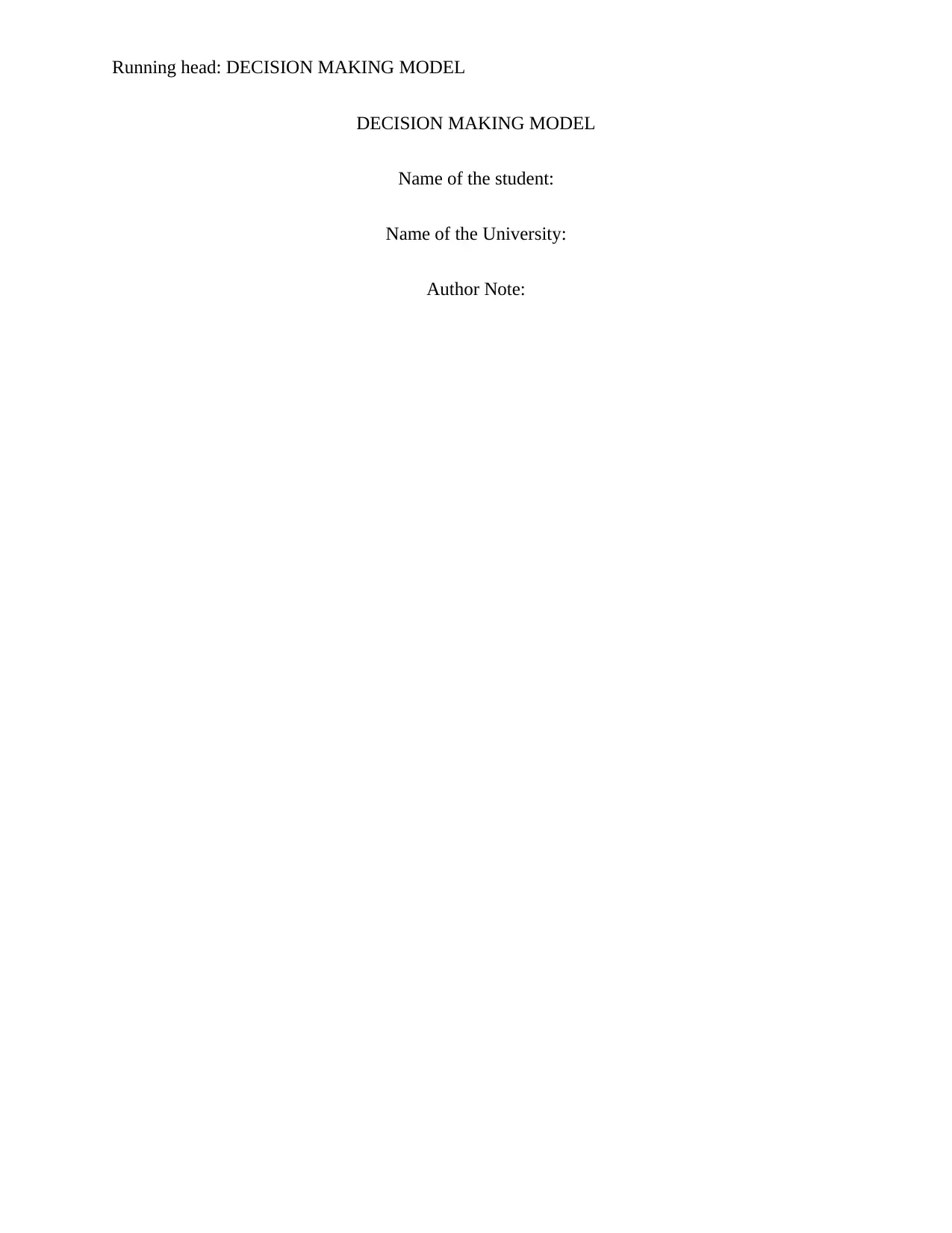
Running head: DECISION MAKING MODEL
DECISION MAKING MODEL
Name of the student:
Name of the University:
Author Note:
DECISION MAKING MODEL
Name of the student:
Name of the University:
Author Note:
Paraphrase This Document
Need a fresh take? Get an instant paraphrase of this document with our AI Paraphraser
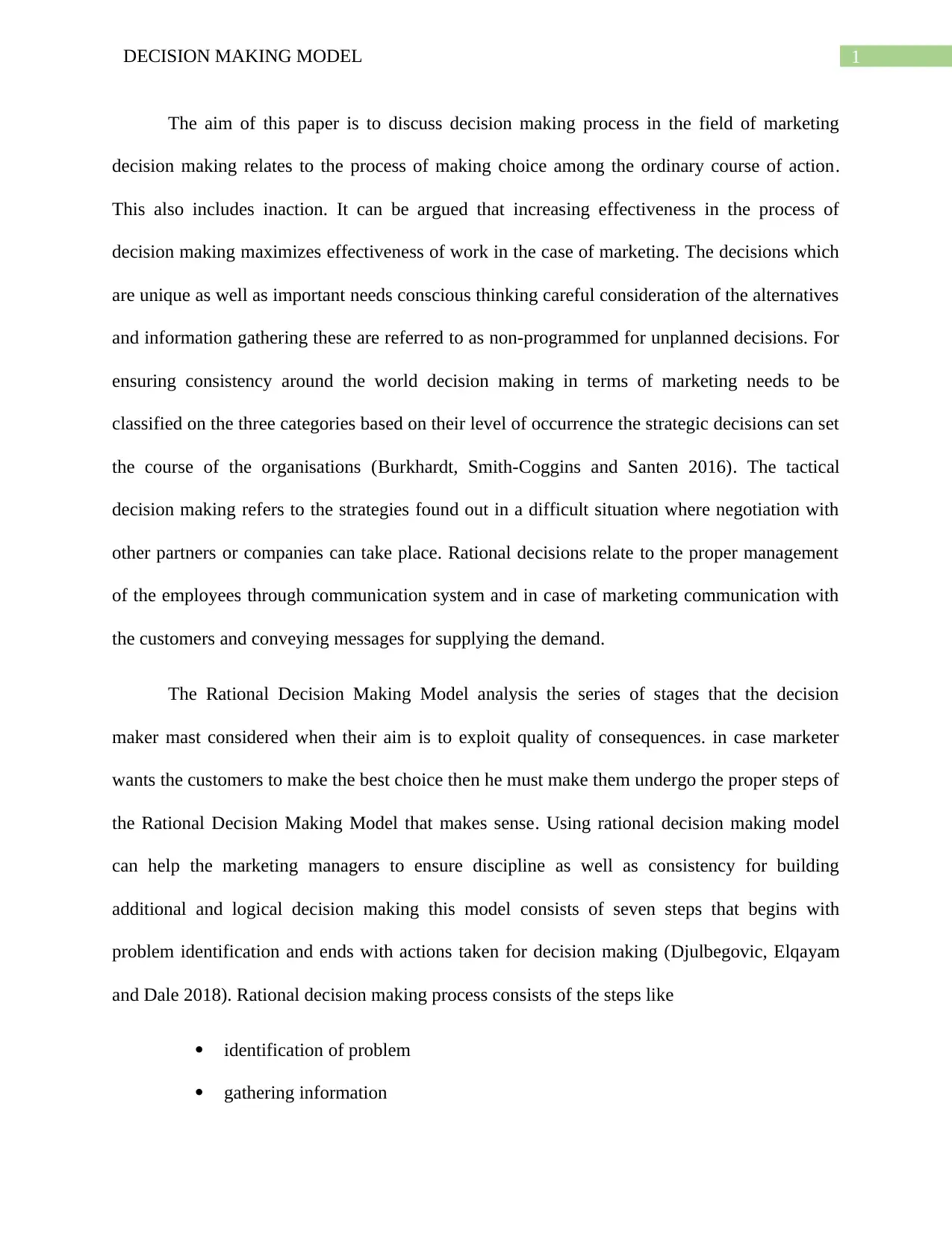
1DECISION MAKING MODEL
The aim of this paper is to discuss decision making process in the field of marketing
decision making relates to the process of making choice among the ordinary course of action.
This also includes inaction. It can be argued that increasing effectiveness in the process of
decision making maximizes effectiveness of work in the case of marketing. The decisions which
are unique as well as important needs conscious thinking careful consideration of the alternatives
and information gathering these are referred to as non-programmed for unplanned decisions. For
ensuring consistency around the world decision making in terms of marketing needs to be
classified on the three categories based on their level of occurrence the strategic decisions can set
the course of the organisations (Burkhardt, Smith-Coggins and Santen 2016). The tactical
decision making refers to the strategies found out in a difficult situation where negotiation with
other partners or companies can take place. Rational decisions relate to the proper management
of the employees through communication system and in case of marketing communication with
the customers and conveying messages for supplying the demand.
The Rational Decision Making Model analysis the series of stages that the decision
maker mast considered when their aim is to exploit quality of consequences. in case marketer
wants the customers to make the best choice then he must make them undergo the proper steps of
the Rational Decision Making Model that makes sense. Using rational decision making model
can help the marketing managers to ensure discipline as well as consistency for building
additional and logical decision making this model consists of seven steps that begins with
problem identification and ends with actions taken for decision making (Djulbegovic, Elqayam
and Dale 2018). Rational decision making process consists of the steps like
identification of problem
gathering information
The aim of this paper is to discuss decision making process in the field of marketing
decision making relates to the process of making choice among the ordinary course of action.
This also includes inaction. It can be argued that increasing effectiveness in the process of
decision making maximizes effectiveness of work in the case of marketing. The decisions which
are unique as well as important needs conscious thinking careful consideration of the alternatives
and information gathering these are referred to as non-programmed for unplanned decisions. For
ensuring consistency around the world decision making in terms of marketing needs to be
classified on the three categories based on their level of occurrence the strategic decisions can set
the course of the organisations (Burkhardt, Smith-Coggins and Santen 2016). The tactical
decision making refers to the strategies found out in a difficult situation where negotiation with
other partners or companies can take place. Rational decisions relate to the proper management
of the employees through communication system and in case of marketing communication with
the customers and conveying messages for supplying the demand.
The Rational Decision Making Model analysis the series of stages that the decision
maker mast considered when their aim is to exploit quality of consequences. in case marketer
wants the customers to make the best choice then he must make them undergo the proper steps of
the Rational Decision Making Model that makes sense. Using rational decision making model
can help the marketing managers to ensure discipline as well as consistency for building
additional and logical decision making this model consists of seven steps that begins with
problem identification and ends with actions taken for decision making (Djulbegovic, Elqayam
and Dale 2018). Rational decision making process consists of the steps like
identification of problem
gathering information

2DECISION MAKING MODEL
analysis of situation
development of options
evaluation of alternatives
selection of preferred alternative
action on the decision.
Identification of problems:
Proper recognition of the problems and seeing opportunities helps initiating solution for
Complex decision making in the decision making lessons the marketers must ask themselves
whether they really have problem and aim to find solution (Mann s2018). Without proper
understanding of the problems no one can find solution about it.
Gathering information:
Gathering information relates to the process of finding the relevant factors in the decision
making. Well equipped with knowledge and subtle information about the problems can help the
marketing managers to get more acquaintance with the problem to find perfect solution.
Analysis of situation:
After identifying the problem and getting information from the every aspects of the
problems, situational analysis becomes easy. The problem solving activities used as a tour
structural actions for encouraging both the brother and analysis of situation and problem.
Development of options:
analysis of situation
development of options
evaluation of alternatives
selection of preferred alternative
action on the decision.
Identification of problems:
Proper recognition of the problems and seeing opportunities helps initiating solution for
Complex decision making in the decision making lessons the marketers must ask themselves
whether they really have problem and aim to find solution (Mann s2018). Without proper
understanding of the problems no one can find solution about it.
Gathering information:
Gathering information relates to the process of finding the relevant factors in the decision
making. Well equipped with knowledge and subtle information about the problems can help the
marketing managers to get more acquaintance with the problem to find perfect solution.
Analysis of situation:
After identifying the problem and getting information from the every aspects of the
problems, situational analysis becomes easy. The problem solving activities used as a tour
structural actions for encouraging both the brother and analysis of situation and problem.
Development of options:
⊘ This is a preview!⊘
Do you want full access?
Subscribe today to unlock all pages.

Trusted by 1+ million students worldwide
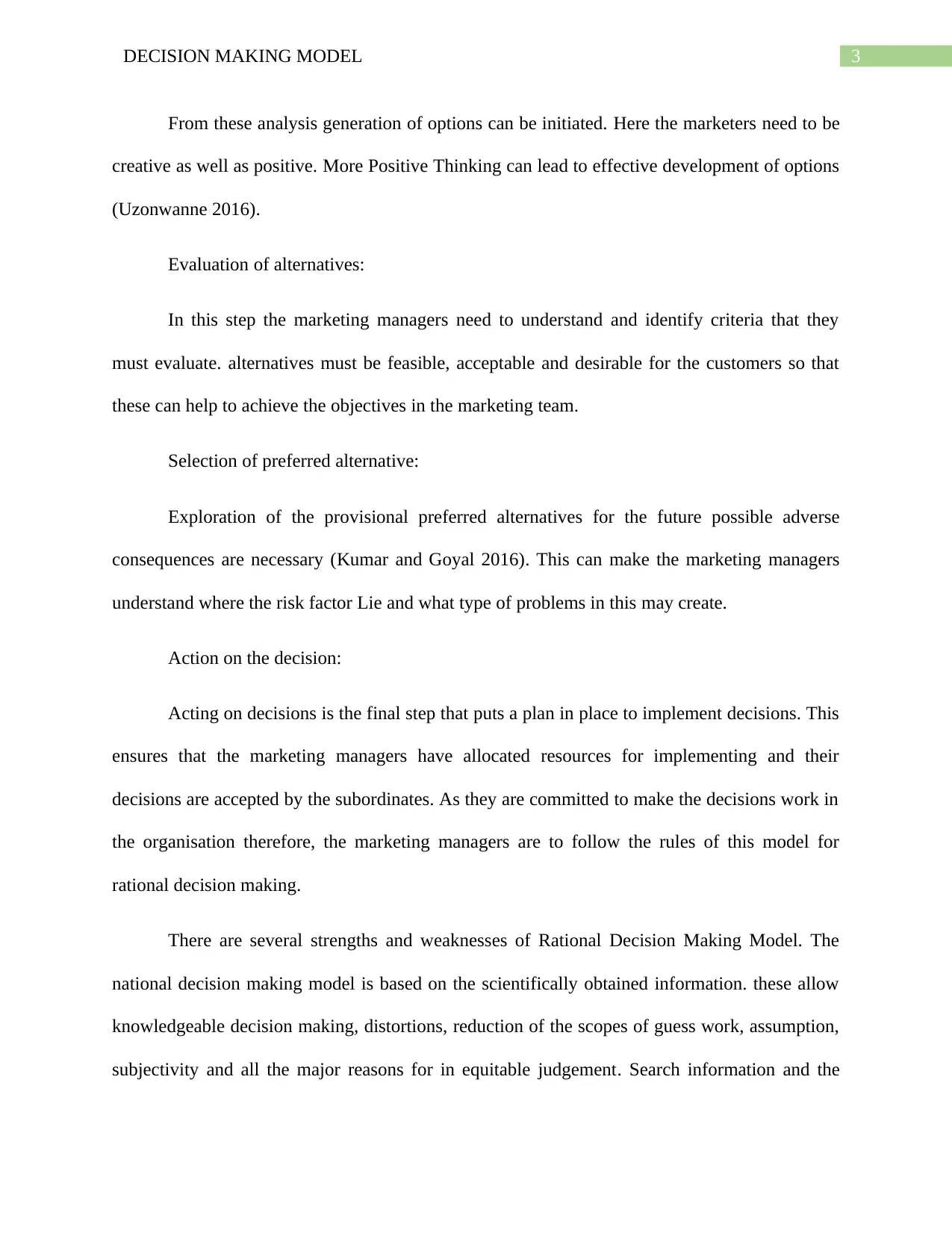
3DECISION MAKING MODEL
From these analysis generation of options can be initiated. Here the marketers need to be
creative as well as positive. More Positive Thinking can lead to effective development of options
(Uzonwanne 2016).
Evaluation of alternatives:
In this step the marketing managers need to understand and identify criteria that they
must evaluate. alternatives must be feasible, acceptable and desirable for the customers so that
these can help to achieve the objectives in the marketing team.
Selection of preferred alternative:
Exploration of the provisional preferred alternatives for the future possible adverse
consequences are necessary (Kumar and Goyal 2016). This can make the marketing managers
understand where the risk factor Lie and what type of problems in this may create.
Action on the decision:
Acting on decisions is the final step that puts a plan in place to implement decisions. This
ensures that the marketing managers have allocated resources for implementing and their
decisions are accepted by the subordinates. As they are committed to make the decisions work in
the organisation therefore, the marketing managers are to follow the rules of this model for
rational decision making.
There are several strengths and weaknesses of Rational Decision Making Model. The
national decision making model is based on the scientifically obtained information. these allow
knowledgeable decision making, distortions, reduction of the scopes of guess work, assumption,
subjectivity and all the major reasons for in equitable judgement. Search information and the
From these analysis generation of options can be initiated. Here the marketers need to be
creative as well as positive. More Positive Thinking can lead to effective development of options
(Uzonwanne 2016).
Evaluation of alternatives:
In this step the marketing managers need to understand and identify criteria that they
must evaluate. alternatives must be feasible, acceptable and desirable for the customers so that
these can help to achieve the objectives in the marketing team.
Selection of preferred alternative:
Exploration of the provisional preferred alternatives for the future possible adverse
consequences are necessary (Kumar and Goyal 2016). This can make the marketing managers
understand where the risk factor Lie and what type of problems in this may create.
Action on the decision:
Acting on decisions is the final step that puts a plan in place to implement decisions. This
ensures that the marketing managers have allocated resources for implementing and their
decisions are accepted by the subordinates. As they are committed to make the decisions work in
the organisation therefore, the marketing managers are to follow the rules of this model for
rational decision making.
There are several strengths and weaknesses of Rational Decision Making Model. The
national decision making model is based on the scientifically obtained information. these allow
knowledgeable decision making, distortions, reduction of the scopes of guess work, assumption,
subjectivity and all the major reasons for in equitable judgement. Search information and the
Paraphrase This Document
Need a fresh take? Get an instant paraphrase of this document with our AI Paraphraser

4DECISION MAKING MODEL
knowledge based method promotes a high quality as well as consistent decision-making which
reduces uncertainties and risks associated with decision. The Rational Decision Making process
in fuses discipline logic and consistency (Hill 2019). This step-by-step approach necessitates
defining of problem, listing numerous alternatives, identifying decision criteria, reflecting
consequences of every substitute and rating these on every criterion. These sequential approach
can allowed the decision makers to arrive at the optimum decision.
The weakness of Rational Decision Making model includes careful reflection and
deliberations of data. This can take time and make this methods unsuitable for the rapid
decisions. In this age of the fast change, properly capturing opportunities at the right moment can
play a bigger part in the success. The Rational Decision Making Model may delay in making
decision that may result in the dilution of benefit for alternative (Hill 2019). the model finds
utilisation mostly to make a long-term policy decisions rather than a short-term operational
decisions. Another weakness of rational decision making model is related to its conservatism.
Many times the marketing managers we follow their instincts to take the risk and seize
opportunities. By limiting decisions to analyse of the available data can stop search approaches.
Unavailability of the past information about the new produces can cause rational decision-
makers to go for more conservative options.
Intuitive decision making model:
Intuitive decision making model refers to arrival he decisions without any conscious
reasoning. 89% of the managers have admitted that they use intuition for making any decision. In
the case of marketing field intuitive decision making model is effective because the managers at
to understand exact need of the customers so that they can bring changes in the product or
services (Okoli, Weller and Watt 2016). Or for that matter this can also add the type of
knowledge based method promotes a high quality as well as consistent decision-making which
reduces uncertainties and risks associated with decision. The Rational Decision Making process
in fuses discipline logic and consistency (Hill 2019). This step-by-step approach necessitates
defining of problem, listing numerous alternatives, identifying decision criteria, reflecting
consequences of every substitute and rating these on every criterion. These sequential approach
can allowed the decision makers to arrive at the optimum decision.
The weakness of Rational Decision Making model includes careful reflection and
deliberations of data. This can take time and make this methods unsuitable for the rapid
decisions. In this age of the fast change, properly capturing opportunities at the right moment can
play a bigger part in the success. The Rational Decision Making Model may delay in making
decision that may result in the dilution of benefit for alternative (Hill 2019). the model finds
utilisation mostly to make a long-term policy decisions rather than a short-term operational
decisions. Another weakness of rational decision making model is related to its conservatism.
Many times the marketing managers we follow their instincts to take the risk and seize
opportunities. By limiting decisions to analyse of the available data can stop search approaches.
Unavailability of the past information about the new produces can cause rational decision-
makers to go for more conservative options.
Intuitive decision making model:
Intuitive decision making model refers to arrival he decisions without any conscious
reasoning. 89% of the managers have admitted that they use intuition for making any decision. In
the case of marketing field intuitive decision making model is effective because the managers at
to understand exact need of the customers so that they can bring changes in the product or
services (Okoli, Weller and Watt 2016). Or for that matter this can also add the type of
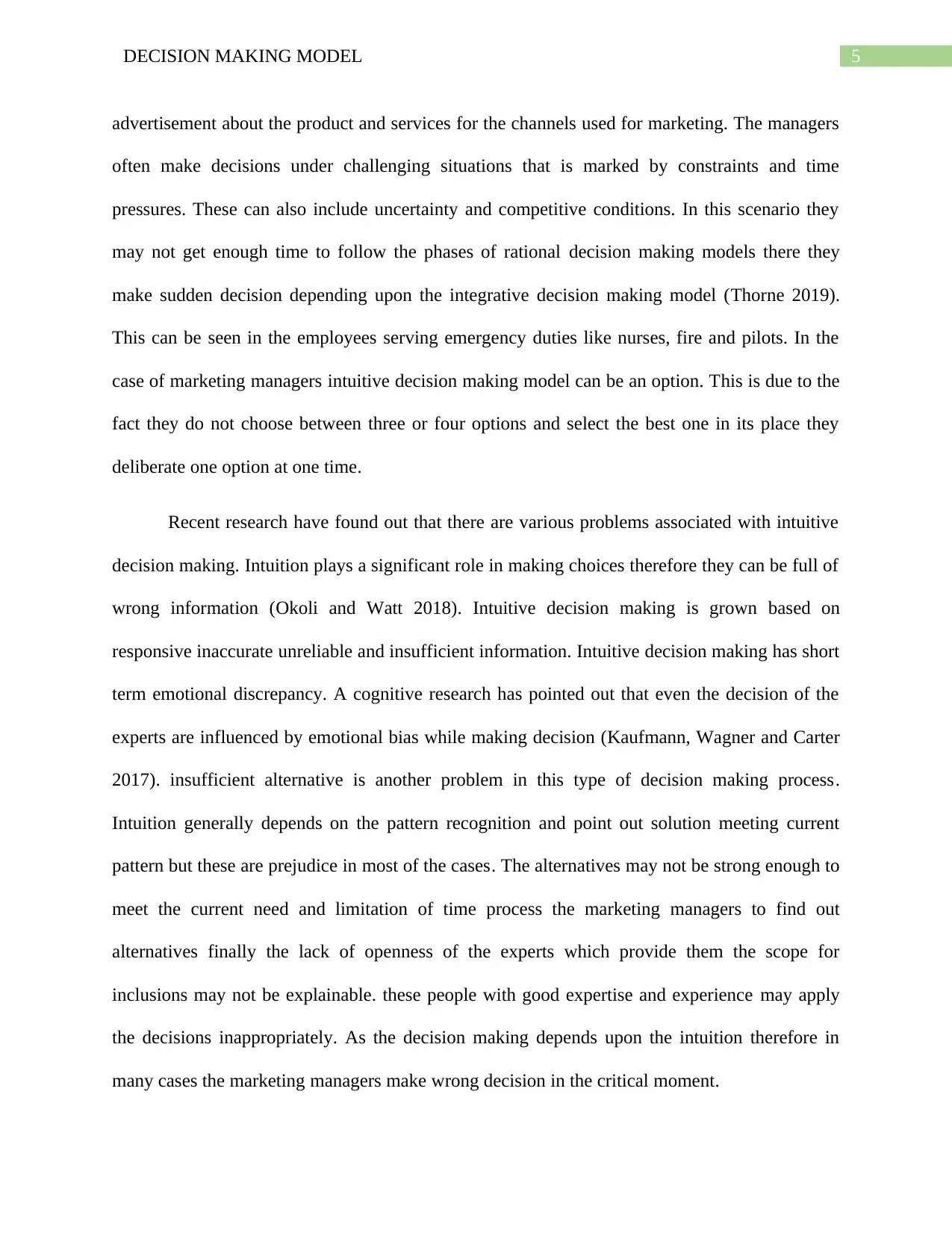
5DECISION MAKING MODEL
advertisement about the product and services for the channels used for marketing. The managers
often make decisions under challenging situations that is marked by constraints and time
pressures. These can also include uncertainty and competitive conditions. In this scenario they
may not get enough time to follow the phases of rational decision making models there they
make sudden decision depending upon the integrative decision making model (Thorne 2019).
This can be seen in the employees serving emergency duties like nurses, fire and pilots. In the
case of marketing managers intuitive decision making model can be an option. This is due to the
fact they do not choose between three or four options and select the best one in its place they
deliberate one option at one time.
Recent research have found out that there are various problems associated with intuitive
decision making. Intuition plays a significant role in making choices therefore they can be full of
wrong information (Okoli and Watt 2018). Intuitive decision making is grown based on
responsive inaccurate unreliable and insufficient information. Intuitive decision making has short
term emotional discrepancy. A cognitive research has pointed out that even the decision of the
experts are influenced by emotional bias while making decision (Kaufmann, Wagner and Carter
2017). insufficient alternative is another problem in this type of decision making process.
Intuition generally depends on the pattern recognition and point out solution meeting current
pattern but these are prejudice in most of the cases. The alternatives may not be strong enough to
meet the current need and limitation of time process the marketing managers to find out
alternatives finally the lack of openness of the experts which provide them the scope for
inclusions may not be explainable. these people with good expertise and experience may apply
the decisions inappropriately. As the decision making depends upon the intuition therefore in
many cases the marketing managers make wrong decision in the critical moment.
advertisement about the product and services for the channels used for marketing. The managers
often make decisions under challenging situations that is marked by constraints and time
pressures. These can also include uncertainty and competitive conditions. In this scenario they
may not get enough time to follow the phases of rational decision making models there they
make sudden decision depending upon the integrative decision making model (Thorne 2019).
This can be seen in the employees serving emergency duties like nurses, fire and pilots. In the
case of marketing managers intuitive decision making model can be an option. This is due to the
fact they do not choose between three or four options and select the best one in its place they
deliberate one option at one time.
Recent research have found out that there are various problems associated with intuitive
decision making. Intuition plays a significant role in making choices therefore they can be full of
wrong information (Okoli and Watt 2018). Intuitive decision making is grown based on
responsive inaccurate unreliable and insufficient information. Intuitive decision making has short
term emotional discrepancy. A cognitive research has pointed out that even the decision of the
experts are influenced by emotional bias while making decision (Kaufmann, Wagner and Carter
2017). insufficient alternative is another problem in this type of decision making process.
Intuition generally depends on the pattern recognition and point out solution meeting current
pattern but these are prejudice in most of the cases. The alternatives may not be strong enough to
meet the current need and limitation of time process the marketing managers to find out
alternatives finally the lack of openness of the experts which provide them the scope for
inclusions may not be explainable. these people with good expertise and experience may apply
the decisions inappropriately. As the decision making depends upon the intuition therefore in
many cases the marketing managers make wrong decision in the critical moment.
⊘ This is a preview!⊘
Do you want full access?
Subscribe today to unlock all pages.

Trusted by 1+ million students worldwide
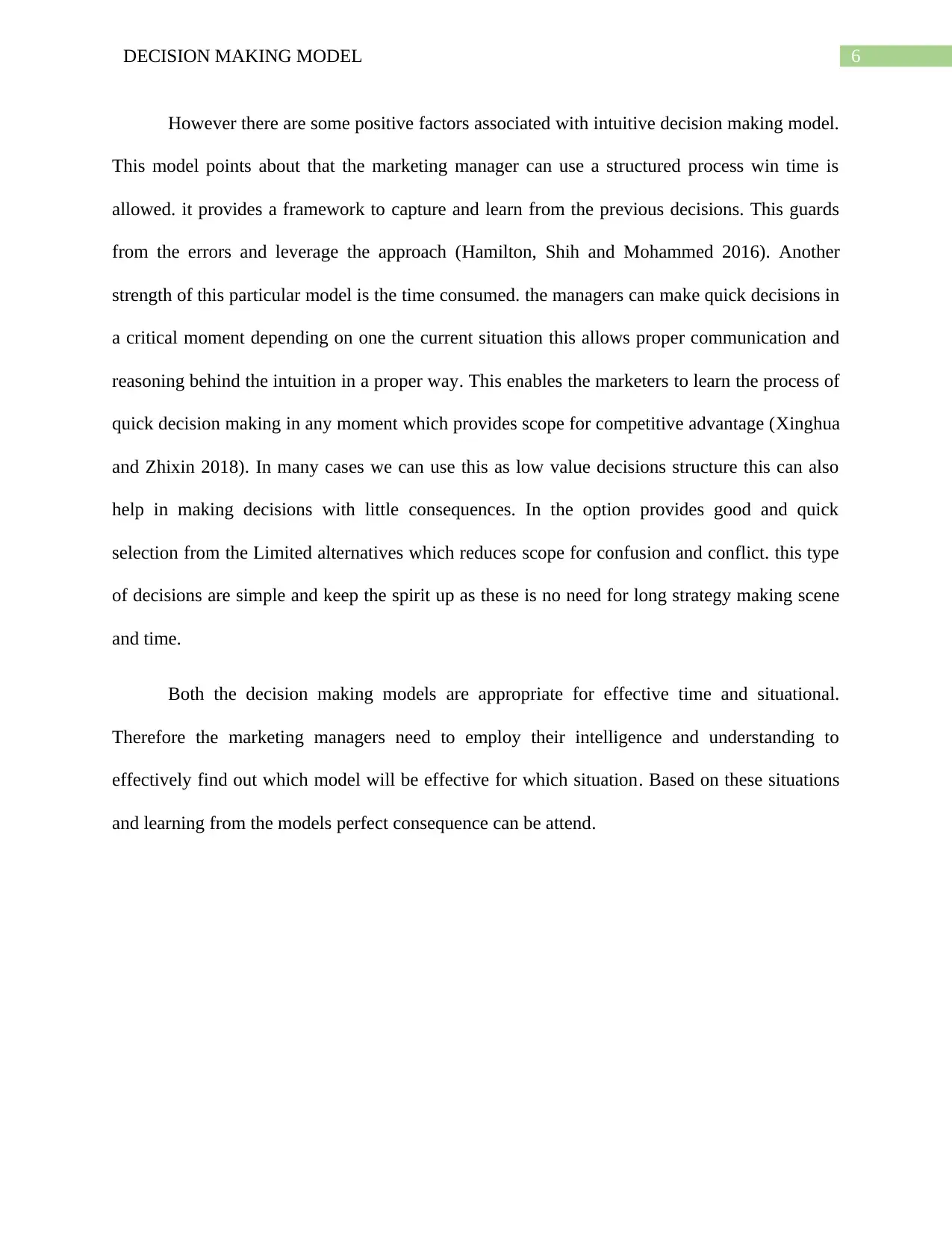
6DECISION MAKING MODEL
However there are some positive factors associated with intuitive decision making model.
This model points about that the marketing manager can use a structured process win time is
allowed. it provides a framework to capture and learn from the previous decisions. This guards
from the errors and leverage the approach (Hamilton, Shih and Mohammed 2016). Another
strength of this particular model is the time consumed. the managers can make quick decisions in
a critical moment depending on one the current situation this allows proper communication and
reasoning behind the intuition in a proper way. This enables the marketers to learn the process of
quick decision making in any moment which provides scope for competitive advantage (Xinghua
and Zhixin 2018). In many cases we can use this as low value decisions structure this can also
help in making decisions with little consequences. In the option provides good and quick
selection from the Limited alternatives which reduces scope for confusion and conflict. this type
of decisions are simple and keep the spirit up as these is no need for long strategy making scene
and time.
Both the decision making models are appropriate for effective time and situational.
Therefore the marketing managers need to employ their intelligence and understanding to
effectively find out which model will be effective for which situation. Based on these situations
and learning from the models perfect consequence can be attend.
However there are some positive factors associated with intuitive decision making model.
This model points about that the marketing manager can use a structured process win time is
allowed. it provides a framework to capture and learn from the previous decisions. This guards
from the errors and leverage the approach (Hamilton, Shih and Mohammed 2016). Another
strength of this particular model is the time consumed. the managers can make quick decisions in
a critical moment depending on one the current situation this allows proper communication and
reasoning behind the intuition in a proper way. This enables the marketers to learn the process of
quick decision making in any moment which provides scope for competitive advantage (Xinghua
and Zhixin 2018). In many cases we can use this as low value decisions structure this can also
help in making decisions with little consequences. In the option provides good and quick
selection from the Limited alternatives which reduces scope for confusion and conflict. this type
of decisions are simple and keep the spirit up as these is no need for long strategy making scene
and time.
Both the decision making models are appropriate for effective time and situational.
Therefore the marketing managers need to employ their intelligence and understanding to
effectively find out which model will be effective for which situation. Based on these situations
and learning from the models perfect consequence can be attend.
Paraphrase This Document
Need a fresh take? Get an instant paraphrase of this document with our AI Paraphraser
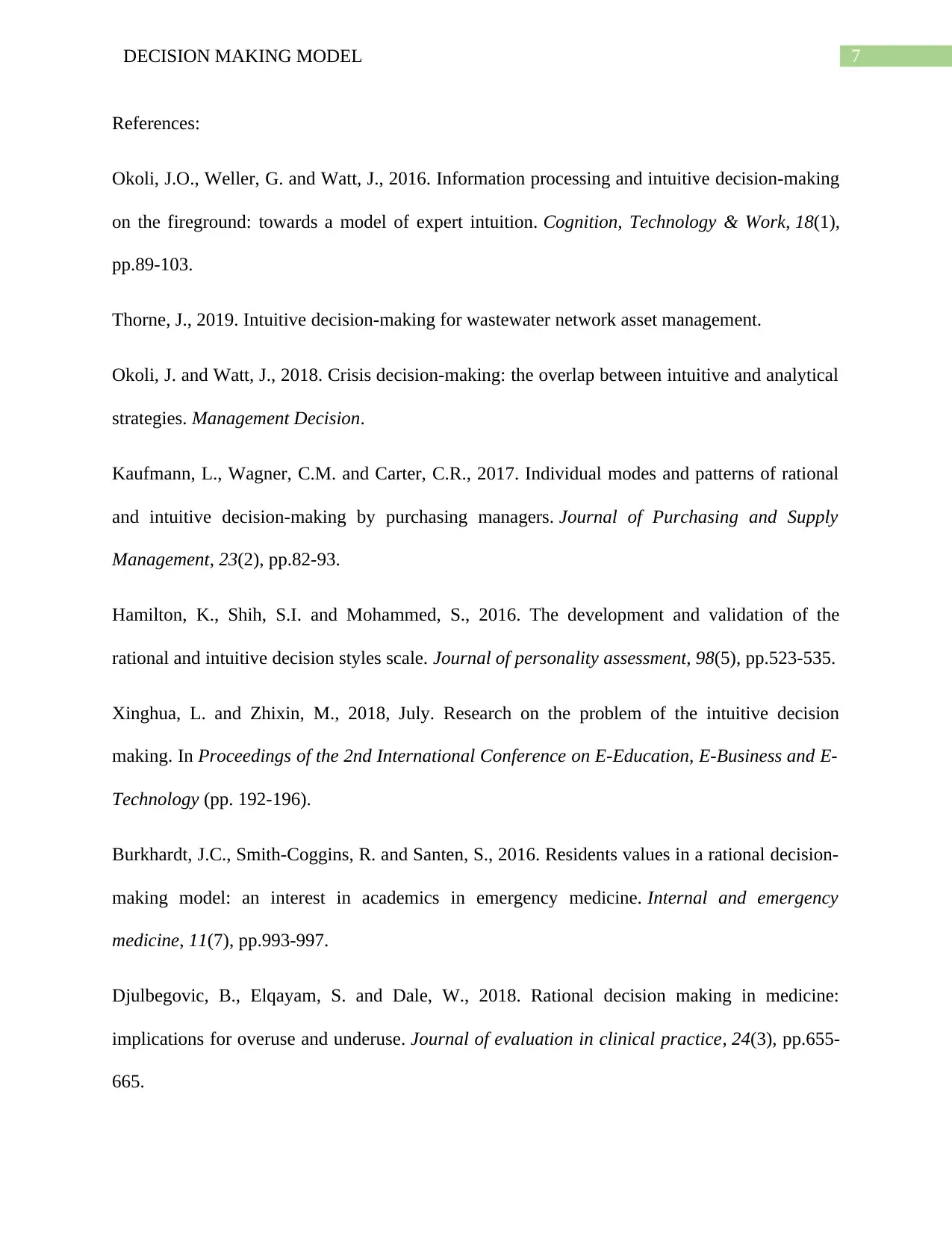
7DECISION MAKING MODEL
References:
Okoli, J.O., Weller, G. and Watt, J., 2016. Information processing and intuitive decision-making
on the fireground: towards a model of expert intuition. Cognition, Technology & Work, 18(1),
pp.89-103.
Thorne, J., 2019. Intuitive decision-making for wastewater network asset management.
Okoli, J. and Watt, J., 2018. Crisis decision-making: the overlap between intuitive and analytical
strategies. Management Decision.
Kaufmann, L., Wagner, C.M. and Carter, C.R., 2017. Individual modes and patterns of rational
and intuitive decision-making by purchasing managers. Journal of Purchasing and Supply
Management, 23(2), pp.82-93.
Hamilton, K., Shih, S.I. and Mohammed, S., 2016. The development and validation of the
rational and intuitive decision styles scale. Journal of personality assessment, 98(5), pp.523-535.
Xinghua, L. and Zhixin, M., 2018, July. Research on the problem of the intuitive decision
making. In Proceedings of the 2nd International Conference on E-Education, E-Business and E-
Technology (pp. 192-196).
Burkhardt, J.C., Smith-Coggins, R. and Santen, S., 2016. Residents values in a rational decision-
making model: an interest in academics in emergency medicine. Internal and emergency
medicine, 11(7), pp.993-997.
Djulbegovic, B., Elqayam, S. and Dale, W., 2018. Rational decision making in medicine:
implications for overuse and underuse. Journal of evaluation in clinical practice, 24(3), pp.655-
665.
References:
Okoli, J.O., Weller, G. and Watt, J., 2016. Information processing and intuitive decision-making
on the fireground: towards a model of expert intuition. Cognition, Technology & Work, 18(1),
pp.89-103.
Thorne, J., 2019. Intuitive decision-making for wastewater network asset management.
Okoli, J. and Watt, J., 2018. Crisis decision-making: the overlap between intuitive and analytical
strategies. Management Decision.
Kaufmann, L., Wagner, C.M. and Carter, C.R., 2017. Individual modes and patterns of rational
and intuitive decision-making by purchasing managers. Journal of Purchasing and Supply
Management, 23(2), pp.82-93.
Hamilton, K., Shih, S.I. and Mohammed, S., 2016. The development and validation of the
rational and intuitive decision styles scale. Journal of personality assessment, 98(5), pp.523-535.
Xinghua, L. and Zhixin, M., 2018, July. Research on the problem of the intuitive decision
making. In Proceedings of the 2nd International Conference on E-Education, E-Business and E-
Technology (pp. 192-196).
Burkhardt, J.C., Smith-Coggins, R. and Santen, S., 2016. Residents values in a rational decision-
making model: an interest in academics in emergency medicine. Internal and emergency
medicine, 11(7), pp.993-997.
Djulbegovic, B., Elqayam, S. and Dale, W., 2018. Rational decision making in medicine:
implications for overuse and underuse. Journal of evaluation in clinical practice, 24(3), pp.655-
665.
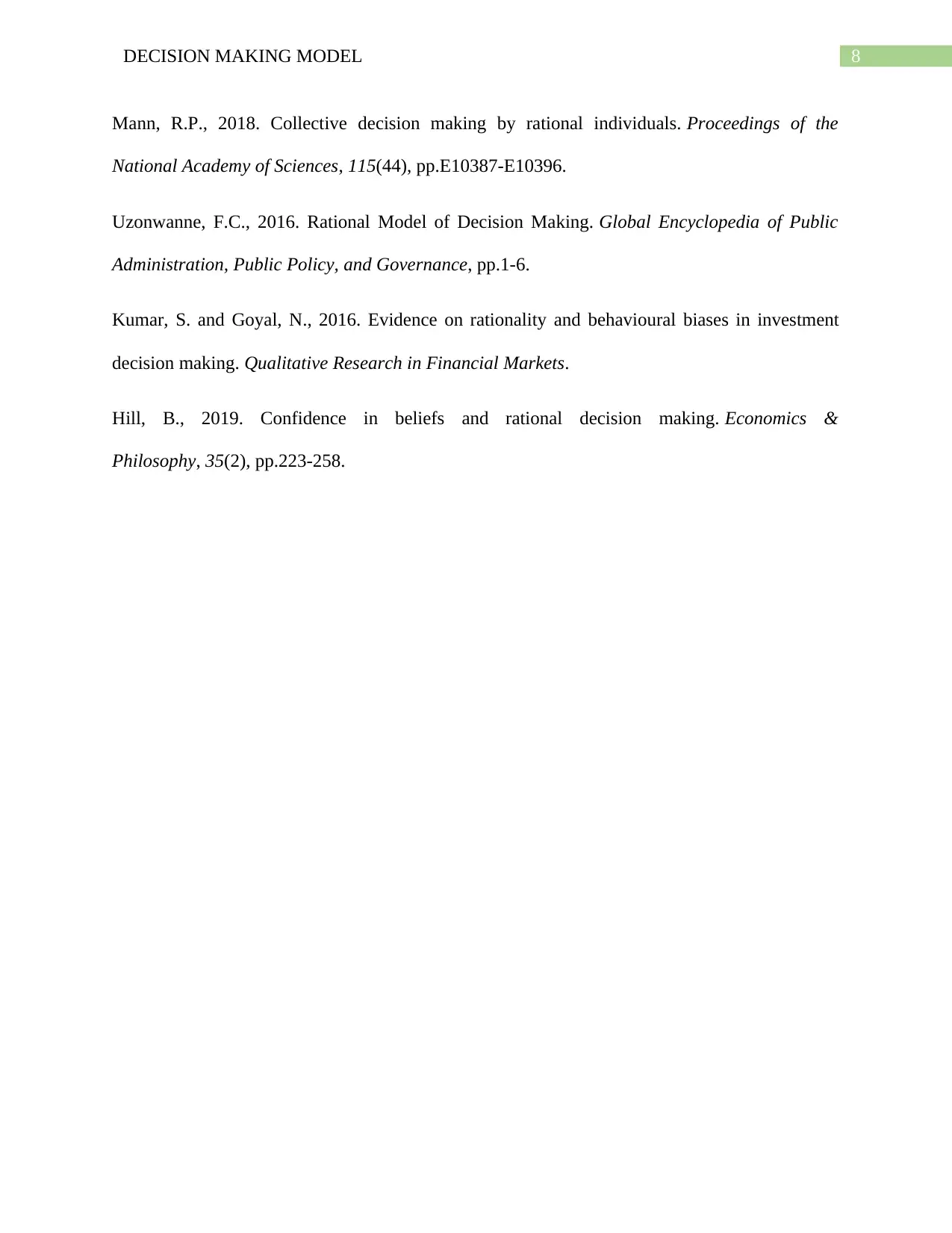
8DECISION MAKING MODEL
Mann, R.P., 2018. Collective decision making by rational individuals. Proceedings of the
National Academy of Sciences, 115(44), pp.E10387-E10396.
Uzonwanne, F.C., 2016. Rational Model of Decision Making. Global Encyclopedia of Public
Administration, Public Policy, and Governance, pp.1-6.
Kumar, S. and Goyal, N., 2016. Evidence on rationality and behavioural biases in investment
decision making. Qualitative Research in Financial Markets.
Hill, B., 2019. Confidence in beliefs and rational decision making. Economics &
Philosophy, 35(2), pp.223-258.
Mann, R.P., 2018. Collective decision making by rational individuals. Proceedings of the
National Academy of Sciences, 115(44), pp.E10387-E10396.
Uzonwanne, F.C., 2016. Rational Model of Decision Making. Global Encyclopedia of Public
Administration, Public Policy, and Governance, pp.1-6.
Kumar, S. and Goyal, N., 2016. Evidence on rationality and behavioural biases in investment
decision making. Qualitative Research in Financial Markets.
Hill, B., 2019. Confidence in beliefs and rational decision making. Economics &
Philosophy, 35(2), pp.223-258.
⊘ This is a preview!⊘
Do you want full access?
Subscribe today to unlock all pages.

Trusted by 1+ million students worldwide
1 out of 9
Related Documents
Your All-in-One AI-Powered Toolkit for Academic Success.
+13062052269
info@desklib.com
Available 24*7 on WhatsApp / Email
![[object Object]](/_next/static/media/star-bottom.7253800d.svg)
Unlock your academic potential
Copyright © 2020–2025 A2Z Services. All Rights Reserved. Developed and managed by ZUCOL.





